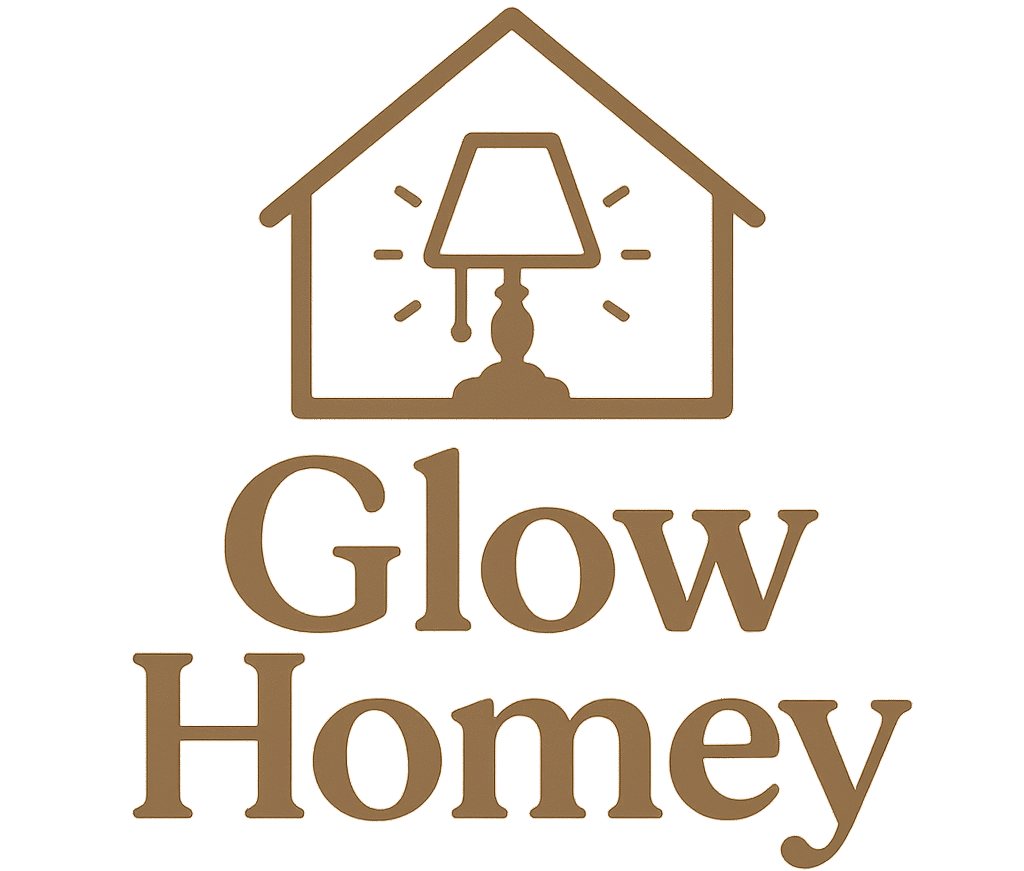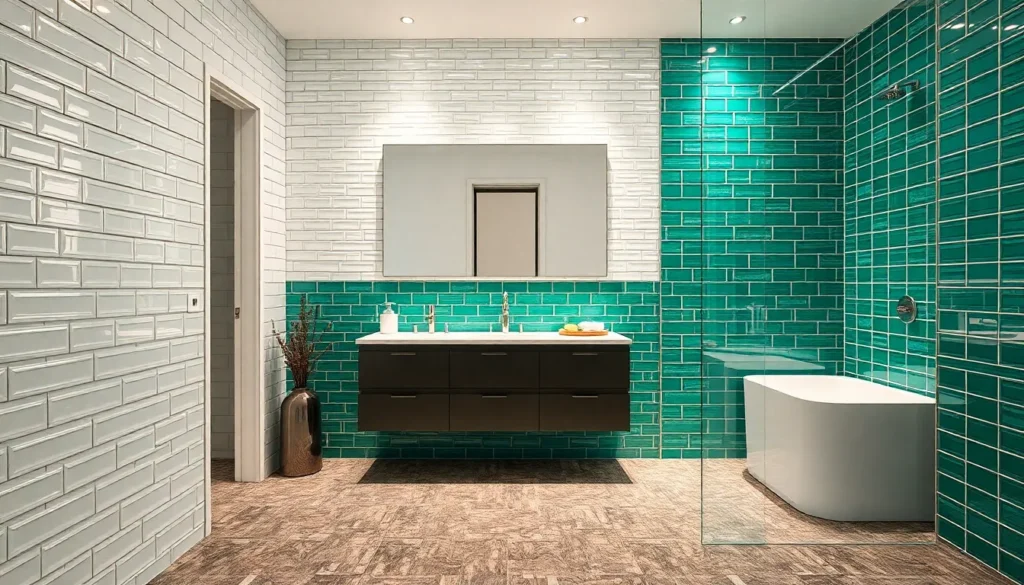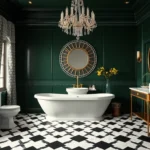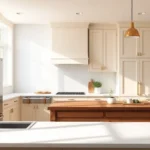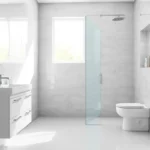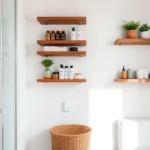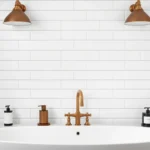Transform your bathroom into a stunning sanctuary with the endless possibilities of glass tiles. These versatile design elements don’t just add visual appeal—they create depth dimension and luxury that traditional ceramic tiles simply can’t match. From subway patterns to mosaic masterpieces glass tiles reflect light beautifully making even the smallest bathrooms feel more spacious and bright.
We’ve discovered that glass tiles offer unmatched versatility in bathroom design. Whether you’re planning a complete renovation or simply updating your shower surround these tiles work seamlessly with any style from modern minimalist to classic traditional. Their non-porous surface resists stains moisture and bacteria making them incredibly practical for high-humidity environments.
Ready to explore the most inspiring glass tile ideas that’ll elevate your bathroom from ordinary to extraordinary? We’ll walk you through creative patterns color combinations and installation tips that professional designers use to create breathtaking bathroom spaces that impress guests and add important value to your home.
Modern Subway Glass Tiles for Timeless Appeal
Glass subway tiles revolutionize traditional bathroom design by combining classic proportions with contemporary materials. We’ve observed how this pairing creates spaces that feel both familiar and fresh.
Classic White Subway Glass Tiles
Traditional charm meets modern sophistication when we incorporate white glass subway tiles into bathroom designs. These tiles reflect light beautifully while maintaining the beloved 3×6 inch proportions that have defined subway style for over a century.
Installation patterns transform the overall aesthetic significantly. We recommend the classic running bond pattern for traditional appeal or herringbone arrangements for contemporary flair. The glossy surface of white glass subway tiles amplifies natural light in ways that ceramic alternatives simply cannot match.
Maintenance becomes effortless with non-porous glass surfaces that resist moisture and staining. We’ve found that a simple wipe-down keeps these tiles looking pristine, making them ideal for busy family bathrooms where cleanliness matters most.
Colored Subway Glass Tile Variations
Bold color choices elevate standard subway layouts into striking design statements. We’ve seen stunning results with deep navy blues, sage greens, and charcoal grays that add personality without overwhelming smaller bathroom spaces.
Gradient installations create visual interest by transitioning from light to dark tones within the same color family. Ocean blues flowing into seafoam greens or warm grays shifting to crisp whites provide sophisticated depth that draws the eye upward.
Accent walls showcase colored glass subway tiles most effectively when we limit their use to single focal points. Behind vanities or in shower areas, these colorful installations become artistic features while neutral tiles handle the remaining surfaces.
Large Format Subway Glass Tiles
Expanded dimensions minimize grout lines while maintaining the beloved subway aesthetic in contemporary proportions. We typically work with 4×12 inch or 6×12 inch formats that create cleaner, more streamlined appearances than traditional sizes.
Visual expansion occurs naturally when larger subway glass tiles cover bathroom walls with fewer interruptions. These proportions make compact bathrooms appear more spacious while reducing cleaning time spent on grout maintenance.
Installation considerations require careful planning since larger tiles demand perfectly level surfaces for optimal results. We recommend professional installation for these formats to ensure proper alignment and prevent lippage that could compromise the sleek appearance.
Mosaic Glass Tile Patterns for Visual Interest
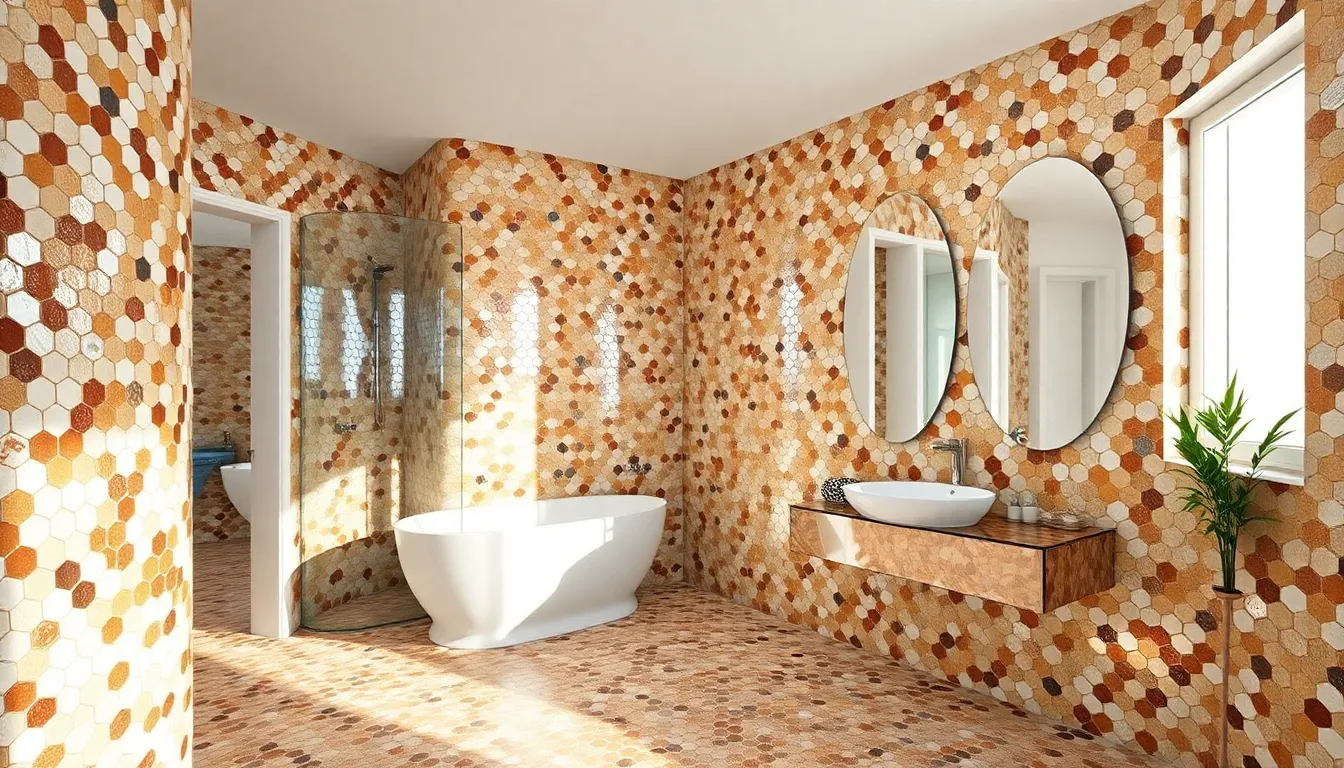
Mosaic glass tiles transform ordinary bathroom spaces into stunning focal points through their ability to create ever-changing visual compositions. These versatile tiles allow us to create intricate patterns that play with light and texture in ways that larger format tiles simply can’t achieve.
Hexagonal Glass Mosaic Designs
Hexagonal glass mosaic tiles offer a modern geometric alternative that instantly elevates any bathroom design. Six-sided tiles create honeycomb formations that provide a sleek and visually distinctive appearance on shower walls, floors, or backsplashes. We love how these geometric shapes add contemporary edge and depth to bathroom spaces.
Different colored grouts can accentuate the unique hexagonal pattern, allowing us to customize the overall look. Modern installations frequently combine multiple hexagon sizes for added visual complexity. Bold color combinations work exceptionally well with hexagonal mosaics, creating striking accent features that draw the eye.
Penny Round Glass Tile Arrangements
Penny round glass tiles create smooth, continuous surfaces through their circular shape and minimal grout lines. Small diameter tiles can be arranged in all-over patterns or used strategically as accent features in shower niches and decorative borders. Reflective surfaces enhance the perception of space while providing subtle textured finishes.
Continuous penny round installations work particularly well for shower floors where their rounded edges feel comfortable underfoot. Various color combinations allow us to create everything from monochromatic sophistication to vibrant rainbow effects. Installation typically requires precise spacing to maintain the clean, flowing appearance these tiles are known for.
Linear Glass Mosaic Installations
Linear glass mosaic tiles emphasize clean lines through vertical, horizontal, or stacked configurations that create visual movement. Vertical arrangements on shower walls generate a sense of height that makes bathrooms feel more spacious. Horizontal installations expand the perceived width of rooms, particularly effective in narrow bathroom layouts.
Stacked linear patterns provide contemporary appeal while maintaining the bright, airy aesthetic that glass finishes deliver. We recommend using linear mosaics as statement walls or accent strips to maximize their elongating effects. Color gradients work exceptionally well with linear installations, creating sophisticated transitions that enhance the overall design flow.
Textured Glass Tiles for Depth and Dimension
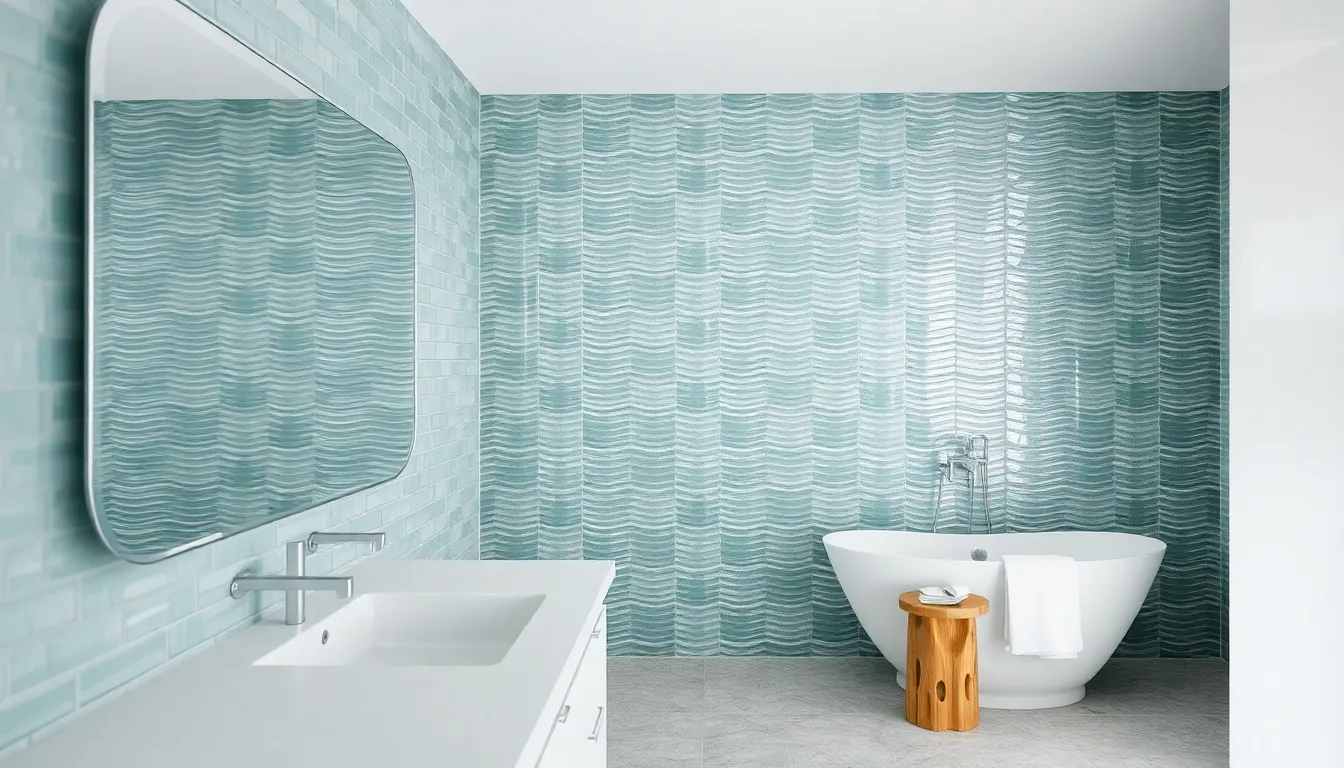
Textured glass tiles create dimensional effects that transform flat bathroom surfaces into captivating focal points. We’ve found these tiles particularly effective for adding visual interest without overwhelming smaller spaces.
Frosted Glass Tile Applications
Frosted glass tiles provide a soft matte finish that creates a calming atmosphere in any bathroom setting. We recommend installing these tiles around mirrors where their reduced glare eliminates harsh reflections during daily grooming routines. Shower enclosures benefit significantly from frosted glass applications since they maintain privacy while allowing natural light to filter through.
Bathroom walls featuring frosted glass tiles offer subtle elegance that complements both modern and traditional design schemes. These tiles work exceptionally well in powder rooms where their gentle luminosity creates an inviting ambiance for guests. We’ve observed that frosted finishes pair beautifully with polished chrome fixtures and natural stone accents.
Rippled Glass Tile Effects
Rippled glass tiles feature wavy patterns that add unique visual elements to bathroom surfaces. Water seems to dance across these undulating textures when light hits them from different angles throughout the day. We often specify rippled tiles for accent walls behind freestanding tubs where their movement creates a spa-like atmosphere.
Shower walls benefit from rippled glass installations that create a sense of fluidity and motion within the space. These tiles work particularly well in contemporary bathrooms where their ever-changing texture contrasts beautifully against smooth surfaces like quartz countertops. Backsplash areas behind vanities gain dramatic appeal when we incorporate rippled glass tiles that catch and reflect ambient lighting.
Raised Pattern Glass Tiles
Raised pattern glass tiles involve intricate designs that extend beyond the surface for dimensional impact. We’ve successfully used these sophisticated tiles to create elegant feature walls that serve as artistic focal points in master bathrooms. Geometric patterns, floral motifs, and abstract designs all translate beautifully into raised glass applications.
Touch becomes an additional sensory element when we incorporate raised pattern tiles into bathroom designs. These tiles add luxury and sophistication that elevates ordinary spaces into extraordinary retreats. We recommend using raised patterns sparingly as accent features rather than covering entire walls to maintain visual balance and prevent overwhelming the space.
Bold Colored Glass Tiles for Statement Walls
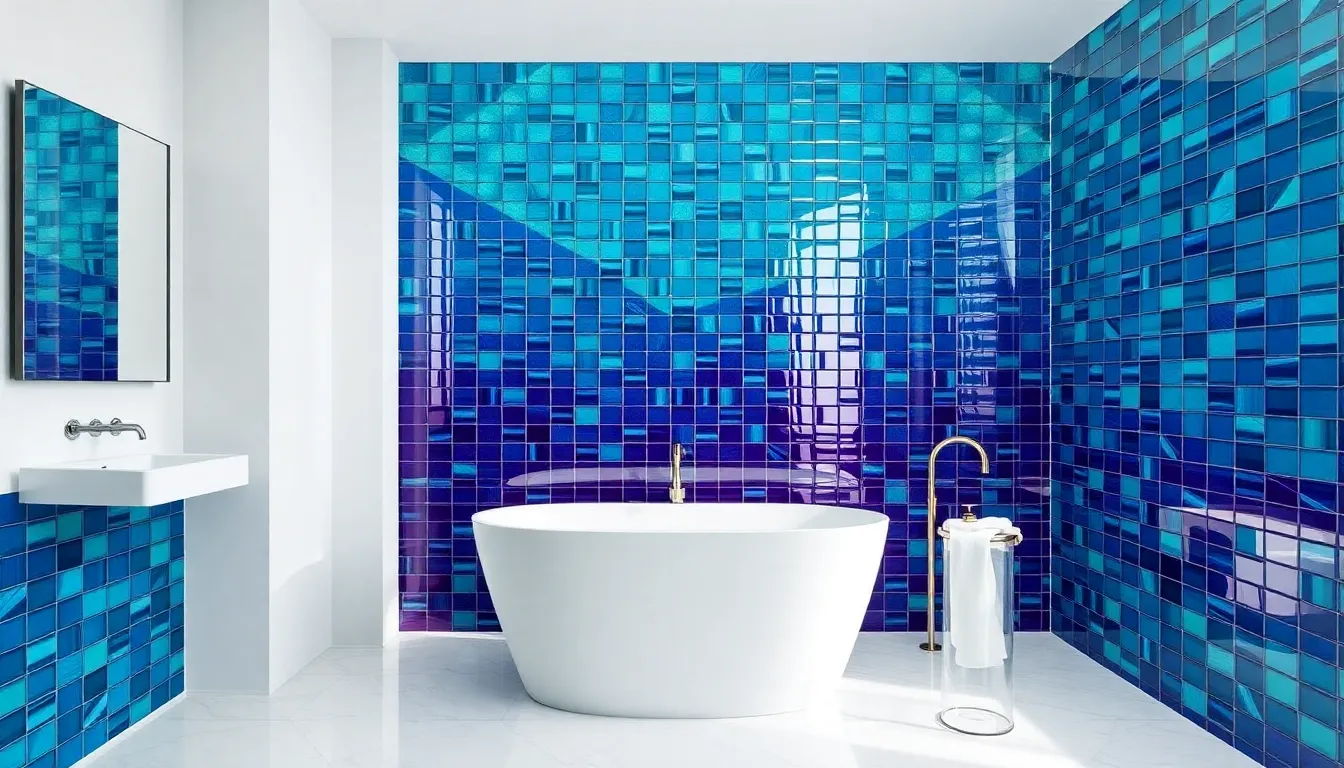
We transform ordinary bathrooms into extraordinary spaces by embracing vibrant glass tiles that create stunning focal points. Combining matte and gloss finishes adds visual depth while bold colors inject personality into your design.
Deep Blue Glass Tile Schemes
Deep blue glass tiles evoke calmness and serenity, making them perfect for creating a spa-like atmosphere in your bathroom. We recommend installing these tiles in herringbone patterns to add visual interest and movement to your walls.
Beach-style bathrooms benefit tremendously from blue glass tile backsplashes, which create soothing and relaxing ambiance. The reflective properties of blue glass amplify natural light while maintaining that tranquil coastal feeling we all crave.
Gradient installations using various blue shades create depth and dimension in smaller bathrooms. Darker blues work beautifully as accent walls, while lighter blues can cover entire surfaces without overwhelming the space.
Emerald Green Glass Tile Accents
Emerald green glass tiles add energy and vibrancy to bathroom designs, creating bold statements that captivate attention. We suggest using these tiles as feature walls behind vanities or in shower enclosures for maximum impact.
Balancing emerald green with neutral colors like white or gray prevents the design from becoming overwhelming. This combination allows the green tiles to shine while maintaining visual harmony throughout the space.
Accent strips of emerald green glass create sophisticated borders around mirrors or windows. These strategic placements draw the eye upward and add color without dominating the entire bathroom aesthetic.
Rich Purple Glass Tile Features
Rich purple glass tiles introduce luxury and sophistication to bathroom spaces, creating dramatic effects that feel both elegant and bold. We recommend using these tiles sparingly as accent features to maintain visual balance.
Combining purple glass with materials like marble or wood enhances the luxurious feel while adding textural contrast. This material mixing creates depth and prevents the purple from appearing too monochromatic.
Feature walls behind freestanding tubs showcase purple glass tiles beautifully, creating a focal point that anchors the entire bathroom design. The reflective quality of glass amplifies the purple’s richness while bouncing light throughout the room.
Iridescent Glass Tiles for Luxury Finishes
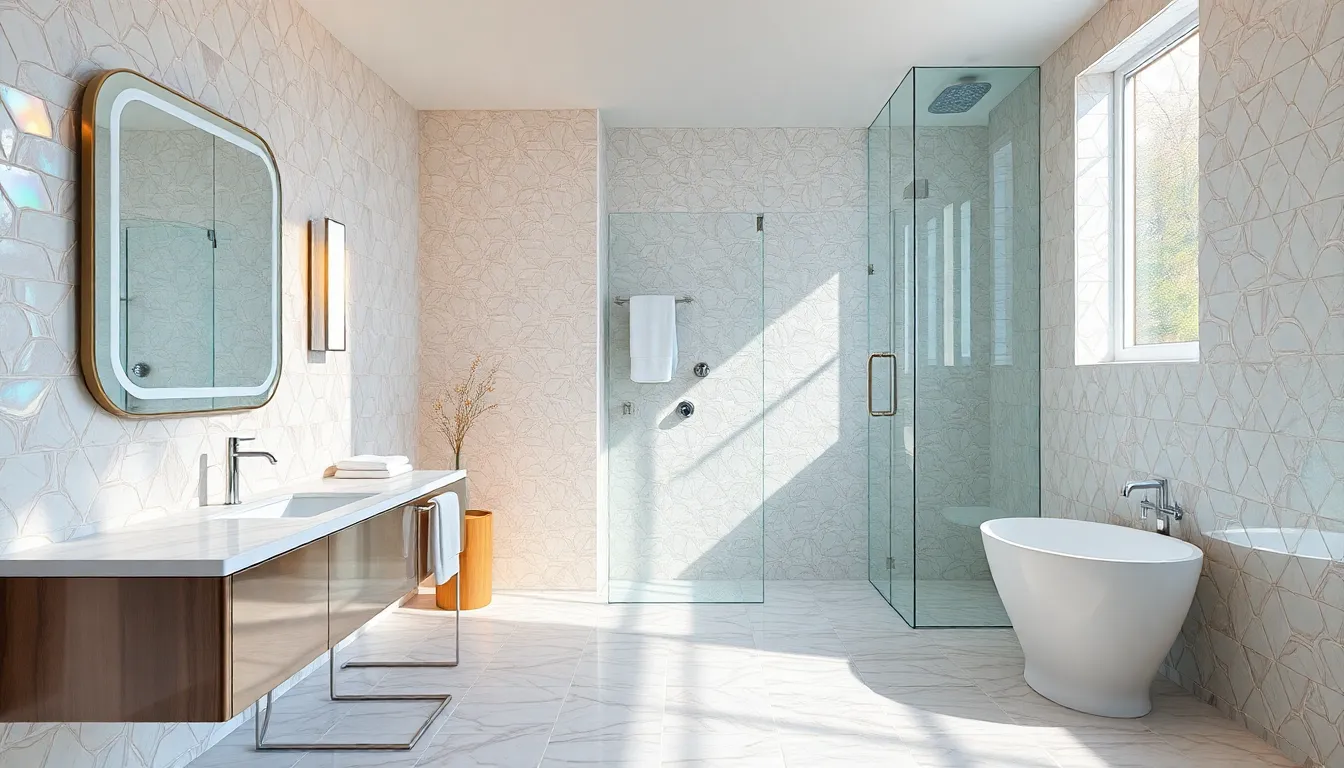
Iridescent glass tiles transform ordinary bathrooms into extraordinary spa-like retreats through their pearlescent finishes that shift color with changing light. These reflective surfaces enhance light diffusion and create the illusion of larger spaces, making them perfect for compact bathroom designs.
Mother-of-Pearl Glass Tile Options
Natural mother-of-pearl pieces embedded in clear glass create an organic luminosity that suits both contemporary and traditional bathroom styles. We recommend these tiles for shower walls and backsplashes where their subtle color shifts add sophisticated texture without overwhelming the space. Installation around vanity areas maximizes their light-catching properties while maintaining an elegant, understated presence.
Different sizes of mother-of-pearl fragments create varying levels of visual interest, from subtle shimmer to bold statement effects. Larger pieces provide dramatic focal points perfect for feature walls, while smaller fragments offer gentle texture ideal for full wall coverage. Consider combining mother-of-pearl tiles with neutral subway tiles to create balanced designs that highlight their natural beauty.
Metallic Finish Glass Tiles
Gold, silver, bronze, and copper-toned metallic glass tiles deliver glamorous modern effects through their reflective film coatings. We suggest using these tiles as accent borders or feature walls to avoid overwhelming smaller bathroom spaces with too much shine. Strategic placement behind vanity mirrors amplifies both natural and artificial light while creating luxurious focal points.
Silver metallic finishes complement contemporary fixtures and create sleek, modern aesthetics perfect for minimalist designs. Bronze and copper tones add warmth to traditional bathrooms and pair beautifully with wood vanities and vintage-inspired accessories. Gold metallic tiles create opulent statements that work exceptionally well in powder rooms and guest bathrooms where dramatic impact is desired.
Color-Changing Glass Tile Effects
Dichroic glass technology enables tiles to transition between multiple colors as lighting conditions and viewing angles change throughout the day. We find these ever-changing effects most impactful when used strategically in shower niches, vanity backsplashes, or as accent strips within larger neutral tile installations. Professional installation ensures proper lighting placement to maximize the color-changing benefits.
Engineering advances make color-changing glass tiles as durable and easy to maintain as standard glass options, though their reflective surfaces require regular cleaning to prevent water spots. Planning the lighting design becomes crucial with these tiles since different light sources create varying color effects. Consider installing adjustable LED lighting to control and enhance the color-changing properties throughout different times of day and various bathroom activities.
Glass Tile Backsplash Ideas Behind Vanities
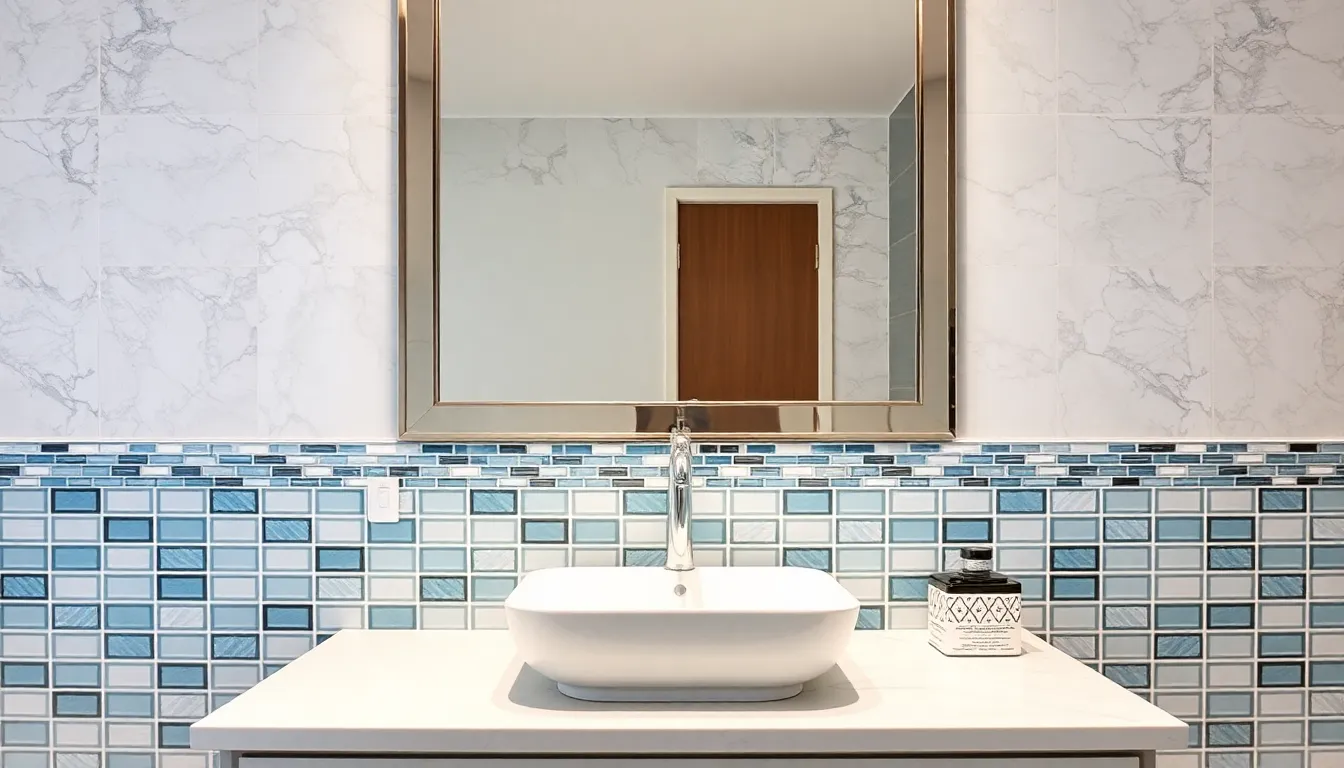
Glass tile backsplashes behind vanities offer the perfect blend of style and practicality for modern bathroom design. These installations protect walls from water damage while reflecting light to brighten your space and create the illusion of more room.
Full Wall Glass Tile Backsplashes
Full wall glass tile backsplashes create seamless, modern looks that transform entire bathroom walls into stunning focal points. These installations cover the complete area from countertop to ceiling, using either large format glass tiles or smaller mosaic styles to enhance visual depth throughout the space.
Coverage options range from single accent walls behind vanities to complete shower surrounds that unify the entire bathroom design. Large format tiles minimize grout lines for a streamlined appearance, while mosaic arrangements add texture and visual interest through varied patterns.
Maintenance Benefits:
- Easy cleaning with standard glass cleaners
- Stain resistant surfaces requiring no sealing
- Mold and mildew resistant properties
- Durable installation lasting decades
Contemporary bathrooms benefit from the sleek appearance these installations provide, while traditional spaces gain modern functionality without sacrificing classic appeal. Professional installation ensures proper waterproofing and alignment for optimal performance.
Partial Glass Tile Accent Strips
Partial glass tile accent strips introduce color, texture, and pattern without overwhelming smaller bathroom spaces. These strategic installations can be positioned horizontally along walls, vertically behind vanities, or within shower niches to break up larger tile fields.
Horizontal strips create width perception in narrow bathrooms, while vertical arrangements add height to rooms with lower ceilings. Installation flexibility allows for custom placement at eye level, chair rail height, or as wainscoting alternatives.
Popular Placement Options:
- Behind floating vanities as accent features
- Around mirror perimeters for framing effects
- Within shower niches as decorative elements
- Along bathtub surrounds for visual continuity
Color coordination with existing fixtures ensures cohesive design flow throughout the bathroom. These accent strips serve as perfect introductions to glass tile for homeowners hesitant about full wall installations.
Decorative Glass Tile Borders
Decorative glass tile borders help define spaces while adding finishing touches to tiled walls and backsplashes. These contrasting elements frame mirrors, shower areas, and feature walls with simple linear designs or intricate motifs that offer endless customization possibilities.
Border installations create visual boundaries that separate different materials or tile patterns within the same space. Contrasting colors highlight architectural features, while complementary tones provide subtle definition without overwhelming the overall design.
Design Applications:
- Mirror frame alternatives using metallic glass borders
- Shower entrance definitions with colored accent borders
- Feature wall perimeters using textured glass strips
- Vanity backsplash edges with geometric pattern borders
Pattern variations include Greek key designs, wave motifs, and geometric repeats that add sophistication to bathroom aesthetics. Installation at different heights creates layered visual interest while maintaining clean, organized appearances that enhance both contemporary and traditional bathroom styles.
Shower Glass Tile Installation Concepts
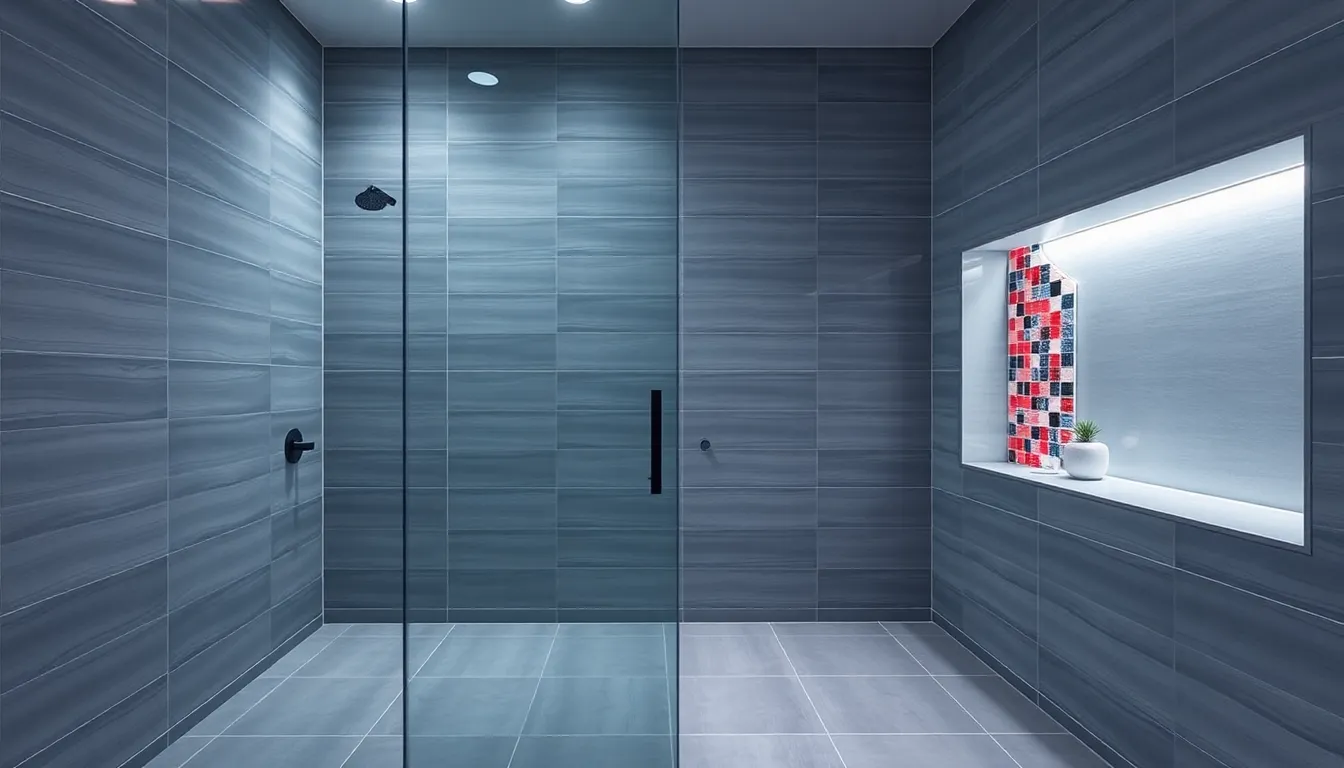
Transforming your shower into a stunning focal point requires strategic glass tile placement that maximizes both visual impact and functionality. We’ll explore innovative installation approaches that create dramatic effects while maintaining practical considerations.
Floor-to-Ceiling Glass Tile Coverage
Monochromatic glass tile installations from floor to ceiling create seamless, spa-like environments that eliminate visual breaks. Matte glass tiles in single color palettes work exceptionally well for this approach, providing cohesive minimalist aesthetics that make compact showers feel significantly larger.
Patterned installations using geometric shapes or striped designs add dramatic flair when extended across entire shower walls. Vertical stripe patterns draw the eye upward, creating impressive height illusions in standard shower enclosures. Geometric formations like hexagons or chevrons establish contemporary sophistication while maintaining visual continuity throughout the space.
Professional installation becomes crucial for floor-to-ceiling applications since tile alignment must remain precise across large surface areas. We recommend using high-quality waterproofing systems behind glass tiles to prevent moisture infiltration in these extensive installations.
Glass Tile Accent Walls in Showers
Accent niches featuring contrasting glass tiles provide both functional storage and stunning visual appeal. These recessed areas become natural showcases for bold colored glass tiles that might overwhelm larger wall sections. Installing glass tile accents in shower niches creates depth while highlighting architectural features.
Color pop accent walls using vibrant glass tiles transform neutral shower spaces into ever-changing environments. Single accent walls behind shower fixtures or opposite the shower entrance provide ideal placement for bold color statements. Emerald green or deep blue glass tiles work particularly well for these feature walls, creating striking contrasts against white or gray surrounding tiles.
Strategic lighting placement enhances glass tile accent walls by amplifying their reflective properties. LED strip lighting positioned above or below accent walls creates dramatic shadow effects that highlight the dimensional qualities of textured glass tiles.
Mixed Material Glass Tile Combinations
Combining glass tiles with concrete creates industrial-modern aesthetics that balance smooth reflective surfaces with raw textural elements. Concrete accent strips or borders paired with glossy glass tiles establish sophisticated contrasts that work beautifully in contemporary shower designs.
Wood-look porcelain tiles mixed with glass mosaics bring warmth to otherwise cool shower environments. These combinations work especially well when glass tiles serve as accent borders or feature strips within predominantly wood-toned installations.
Herringbone patterns using alternating glass and natural stone tiles create balanced textures that prevent overwhelming visual effects. Large format tiles combined with glass mosaic accents provide scale variation that adds interest without sacrificing cohesion. Metal trim pieces between different materials ensure clean transitions while protecting tile edges from water damage.
Small Bathroom Glass Tile Solutions

Maximizing the potential of compact bathrooms becomes effortless when we strategically incorporate glass tiles into our design approach. Glass tiles offer unique advantages for smaller spaces by creating visual expansion while maintaining practical functionality.
Light-Reflecting Glass Tile Placement
Backsplash installations behind vanities transform limited spaces by bouncing light throughout the room and creating depth perception. We recommend installing glass tiles from the countertop to the ceiling to maximize the reflective surface area and enhance the sense of openness.
Corner positioning amplifies natural light from windows while making compact bathrooms feel more spacious. Strategic placement in corners allows light to bounce between surfaces, creating a brighter environment that visually expands the room’s boundaries.
Accent wall applications using glass tiles reflect ambient light while adding visual interest without overwhelming smaller spaces. We suggest choosing one focal wall, such as behind the toilet or adjacent to the shower, to create a stunning centerpiece that doubles the perceived lighting.
Space-Maximizing Glass Tile Layouts
Herringbone patterns create ever-changing visual movement that draws the eye across the space and makes bathrooms feel significantly larger. This classic layout technique adds sophisticated texture while maintaining the light-reflecting properties that glass tiles provide.
Linear arrangements establish visual flow that extends the perceived length and depth of narrow bathroom configurations. We recommend horizontal linear patterns for width enhancement and vertical installations to emphasize ceiling height in compact spaces.
Vertical tile installation emphasizes ceiling height and creates the illusion of expanded vertical space in smaller bathrooms. Floor-to-ceiling glass tile placement eliminates visual breaks that can make rooms feel cramped and confined.
Compact Bathroom Glass Tile Designs
Monochromatic color schemes using glass tiles create cohesive visual flow that makes small bathrooms appear more spacious and unified. We suggest selecting neutral tones like soft whites, pale grays, or subtle blues to maintain the sense of openness while adding sophisticated style.
Patterned accent features incorporate visual interest through strategic glass tile placement without overwhelming limited square footage. Small geometric patterns or subtle texture variations work best as accent elements rather than dominant design features.
Integrated niche storage combines functionality with aesthetic appeal by incorporating glass tile-lined recesses for toiletries and bath essentials. These built-in storage answers eliminate clutter while adding color and texture through thoughtful tile selection and placement.
Glass Tile Maintenance and Care Tips
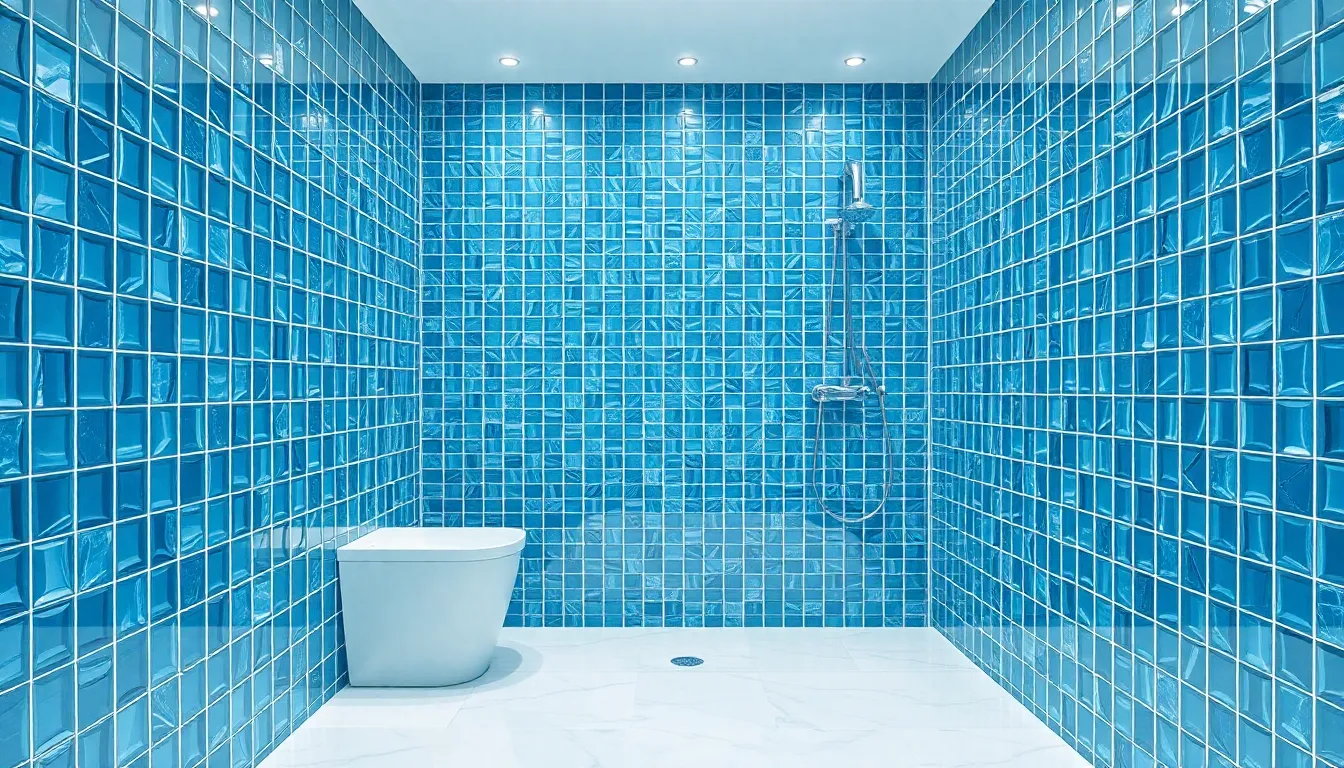
Glass tiles bring stunning visual appeal to bathrooms, but their reflective surfaces require exact care to maintain their pristine appearance. We’ll share proven maintenance strategies that keep your glass tiles sparkling while preserving their longevity.
Daily Cleaning Routines for Glass Tiles
Simple daily maintenance prevents most common glass tile issues. After every shower, we recommend wiping down glass tile surfaces with a soft, lint-free cloth or squeegee to remove water droplets immediately. This prevents water spots from forming on the reflective surface.
Gentle cleaning answers work best for daily care. Mix warm water with a few drops of dish soap to create an effective, non-abrasive cleaner. We avoid harsh chemicals, abrasives, or rough sponges that can dull or scratch the glass finish.
Quick daily wipes save hours of deep cleaning later. Focus on areas that receive the most water exposure, particularly around shower heads and faucets where soap residue tends to accumulate.
Deep Cleaning Glass Tile Surfaces
Weekly deep cleaning maintains the brilliant shine of glass tiles. We create a solution using equal parts warm water and white vinegar, or use a commercial glass cleaner for tougher buildup. Apply the solution with a soft cloth or sponge, working in small sections.
Grout lines require special attention during deep cleaning sessions. Gently scrub grout areas with a soft brush to remove accumulated soap scum and mineral deposits. The non-porous nature of glass tiles means they don’t harbor bacteria or mildew like traditional materials.
Proper rinsing and drying complete the deep cleaning process. Rinse thoroughly with clean water after cleaning, then buff dry with a microfiber cloth to prevent streaks and maintain the glass’s reflective properties.
Preventing Water Spots and Soap Buildup
Proactive prevention reduces maintenance time significantly. Remove excess water from glass tiles immediately after each use, focusing on horizontal surfaces where water pools naturally. Regular use of a squeegee or microfiber cloth helps prevent mineral deposits from forming.
Proper ventilation plays a crucial role in prevention. Ensure your bathroom has adequate ventilation to reduce humidity levels, which contribute to water spots and soap film formation on glass surfaces.
Strategic timing of cleaning prevents stubborn buildup. Address soap residue and water spots while they’re fresh rather than allowing them to set and become more difficult to remove. This approach maintains the stain-resistant qualities that make glass tiles superior to porous materials.
Conclusion
Glass tiles offer an unmatched opportunity to transform your bathroom into a sophisticated and visually stunning space. From classic subway patterns to bold colored accents and innovative textured designs we’ve explored countless ways to incorporate these versatile materials into your renovation project.
The beauty of glass tiles lies in their ability to work seamlessly across different design styles and bathroom sizes. Whether you’re looking to create a spa-like retreat with iridescent finishes or add practical elegance with easy-to-maintain surfaces these tiles deliver both form and function.
With proper installation and regular care your glass tile investment will continue to enhance your bathroom’s beauty and value for years to come. Now it’s time to choose the perfect glass tile solution that reflects your personal style and transforms your vision into reality.
Frequently Asked Questions
What are the main benefits of using glass tiles in bathrooms?
Glass tiles offer exceptional visual appeal, creating depth and luxury that traditional ceramic tiles cannot match. They’re non-porous, making them ideal for high-humidity environments, and their light-reflecting properties make spaces appear larger and brighter. Glass tiles are also stain-resistant, easy to clean, and add significant value to your home while providing versatile design options for any style.
How do subway glass tiles differ from traditional ceramic subway tiles?
Subway glass tiles blend classic proportions with contemporary materials, offering superior light reflection and a more luxurious appearance than ceramic alternatives. They’re easier to maintain, completely non-porous, and available in various colors and finishes. Glass subway tiles create a more polished, sophisticated look while maintaining the timeless appeal of the classic subway pattern.
What are the best glass tile patterns for small bathrooms?
For small bathrooms, linear patterns and herringbone designs work exceptionally well as they create visual movement and flow. Vertical installations make ceilings appear higher, while horizontal patterns expand perceived width. Monochromatic color schemes with light-reflecting glass tiles maximize the sense of space, and strategic accent strips can add interest without overwhelming the area.
Are textured glass tiles suitable for shower installations?
Yes, textured glass tiles are excellent for showers, particularly rippled and raised pattern varieties. They create dimensional effects and visual interest while maintaining water resistance. Frosted glass tiles work well around shower enclosures for privacy, while rippled patterns add fluidity. However, ensure proper installation and sealing for optimal performance in high-moisture areas.
How do I maintain and clean glass tiles properly?
Daily maintenance involves wiping surfaces with a soft cloth or squeegee after use to prevent water spots. Use warm water and gentle dish soap for regular cleaning, avoiding abrasive cleaners. Weekly deep cleaning helps preserve shine, with special attention to grout lines. Proper ventilation and immediate removal of excess water are essential preventative measures.
Can colored glass tiles work in traditional bathroom designs?
Absolutely! Colored glass tiles can complement traditional designs when used thoughtfully. Deep blues and emerald greens work well as accent features, while mother-of-pearl glass tiles suit both contemporary and traditional styles. The key is balancing bold colors with neutral elements and using them sparingly as focal points rather than overwhelming the entire space.
What’s the difference between mosaic and large format glass tiles?
Mosaic glass tiles feature smaller pieces that create intricate patterns and allow for curved installations, perfect for detailed designs and accent features. Large format glass tiles minimize grout lines for a streamlined, modern appearance and make spaces feel larger. Mosaics offer more design flexibility, while large format tiles provide easier maintenance and contemporary aesthetics.
Do iridescent glass tiles require special lighting considerations?
Yes, iridescent and color-changing glass tiles perform best with strategic lighting design. Their dichroic properties allow them to shift colors based on lighting conditions, so professional lighting consultation is recommended. Position them where they’ll catch both natural and artificial light, such as shower niches or accent strips, to maximize their transformative visual effects.
Are glass tiles more expensive than ceramic alternatives?
Glass tiles typically cost more upfront than ceramic tiles, but they offer superior durability, easier maintenance, and higher home value returns. Their non-porous nature means less replacement over time, and their light-reflecting properties can reduce lighting needs. Consider glass tiles an investment in both aesthetics and long-term functionality rather than just an expense.
Should I hire a professional for glass tile installation?
Professional installation is highly recommended, especially for large format tiles, textured varieties, and complex patterns. Glass tiles require specific cutting tools, proper adhesives, and precise techniques to prevent cracking. Professional installers ensure optimal results, proper waterproofing, and can maximize the visual impact of specialty tiles like iridescent or color-changing varieties.
